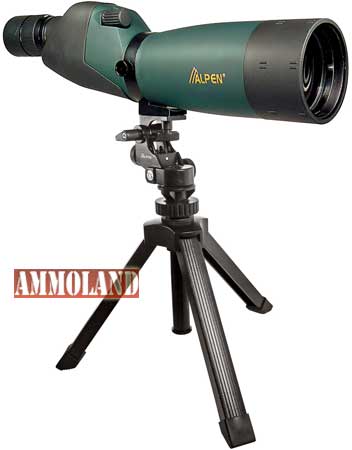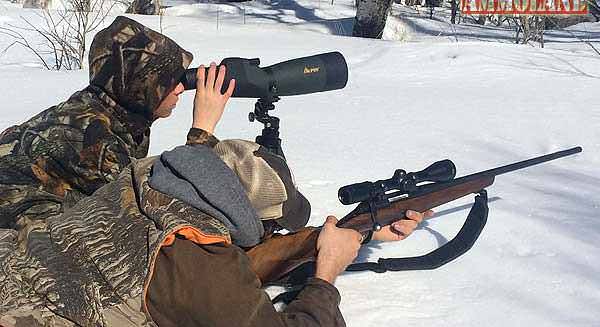
Grand Junction, Co. –-(Ammoland.com)- When you head to the field for any outdoor adventure, we all know that your binoculars are as essential as your rifle, shotgun, fishing or camping gear.
While God gave us all two eyes and relatively good vision, the truth is—most animals have eyesight far superior to humans.
And while binocs of 8-10 times magnification are good for seeing what is relatively close, if you want to see far away game, mountain tops, birds or that old ghost town perched on the side of hill where even mountain goats don’t tread, it’s time for a lightweight, quality spotting scope!
As an outdoor-adventure loving kid back in the 1960s, I had an uncle in the Air Force that gave me a 30x military surplus spotting scope. At the time it was “state-of-the-art” optics. His story to me is that it was used by spotters in Viet Nam to “recon” a village before heading in. It’s no wonder we lost the war! It was big. It was heavy. It was not really waterproof, and the optics were crappy and fuzzy. Even set on a tripod, it seemed like even a small breeze could knock it out of alignment. Touch the eyepiece with your eyebrow, and the world would blur.
I ended up trading it for a pet gopher snake and cage, and to this day I swear I got the better part of the deal!
Fast forward to 2015, and the optics for spotting scopes has undergone a revolution in terms of technology. Today’s scopes, such as the ones from Alpen Optics cover the gamut of everything from the budget-conscious entry level models, all the way to super high-grade models designed for pro use. Most feature adjustable magnification power that starts at around 15-20X and goes up to 45-60X (or more), by simply adjusting the magnification ring/setting.
And while “magnification power” may be the buzz-word for making you think that larger/closer is better or best, if it is not backed up with superior lenses, a quality prism system and good/great light gathering capabilities, that spotting scope is likely to end up being little more than a 5-pound weight in your daypack that isn’t going to do more than give you an inferior and frustrating look at game or scenic’s.
Beginning with the basics, spotting scopes like binoculars are going to use either a porro or roof-prism system. Both have advantages and disadvantages, and in the world of modern optics it often comes down to personal preference.
The Porro Prism is an older design, but thanks to technological improvements in glass, coatings, etc., they are an outstanding choice for just about all outdoor hunting and viewing. They generally are slightly larger and heavier than a roof-prism design, but are less expensive and ruggedized for the outdoors. In a general sense, quality Porro prism scopes are optically better than inexpensive prism models.
If you are on a budget, Alpen’s Porro systems are going to give you the best value!
Once you decide on the magnification power you need, and the basic design of the scope, it’s equally critical to give thought to how well that spotting scope does in terms of gathering light. Porro prism systems traditionally offer better light capabilities, and that can be a real plus when spotting and trying to ID game at dawn, dusk or in crappy weather.

Alpen Optics has spotting scopes come with a choice of either a 60mm or an 80mm objective lens. While a 20mm difference may not seem that significant, all you have to do is look through each—side by side—and the difference is pretty stunning! The Alpen #786 spotting scope with its 20-60X magnification power and the larger 80mm objective lens is a Top Choice for sportsmen looking for quality field optics at an affordable price.
The #786 measures 17-inches in length, is waterproof/rubber armor coated and tips the scales at 56 ounces. It’s no lightweight, but is well worth lugging in your gear for long range viewing. It features a straight-inline eyepiece that quickly cranks from 20X magnification up to 60X power. The magnification adjustment on the eyepiece is large, turns easily and can be operated even when wearing heavy gloves.
The “sister” this spotting scope is the Alpen Optics #788 , and only real difference is that it has a 45-degree angle eyepiece. It’s a few dollars more expensive, but can give you the option of slightly lowering your profile for viewing, by rotating the eyepiece down to a more comfortable prone-position.

Both scopes come with lens caps, a padded nylon carry bag and a vertical/horizontal metal tabletop tripod that’s great for using when spotting targets from a shooting bench. When it’s time to head for the field, the Alpen spotting scopes easily screw in/attach to nearly any larger sportsman’s tripod.
Like all the Alpen Optic products, they’re backed with a no-nonsense, no-questions asked lifetime guarantee. As tough as I am on all my outdoor optics, I’ve yet to have to see how that works with them!
For further information about Alpen Optics Spotting scopes and other optics, go to www.alpenoptics.com .
About:
Andy Lightbody is a TV/Video producer and host, as well as an outdoor writer/photographer. Lightbody is the former Managing Editor for Western Outdoors Magazine; Senior Editor at Petersen’s Hunting Magazine and Editor of the Guns & Ammo Book Division.
He remains an avid shooter, hunter and angler, as well as a regular contributor to the Sportsman’s Warehouse publication-Sportsman’s News Magazine. Visit Rocky Mountain Television/Productions : www.rmtv.net
